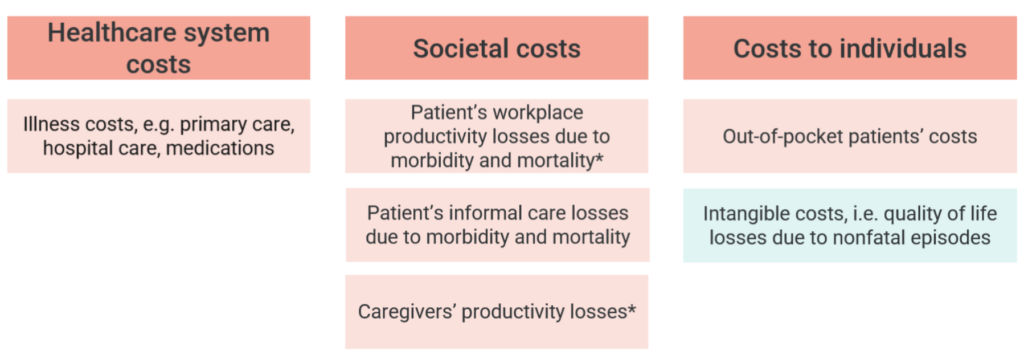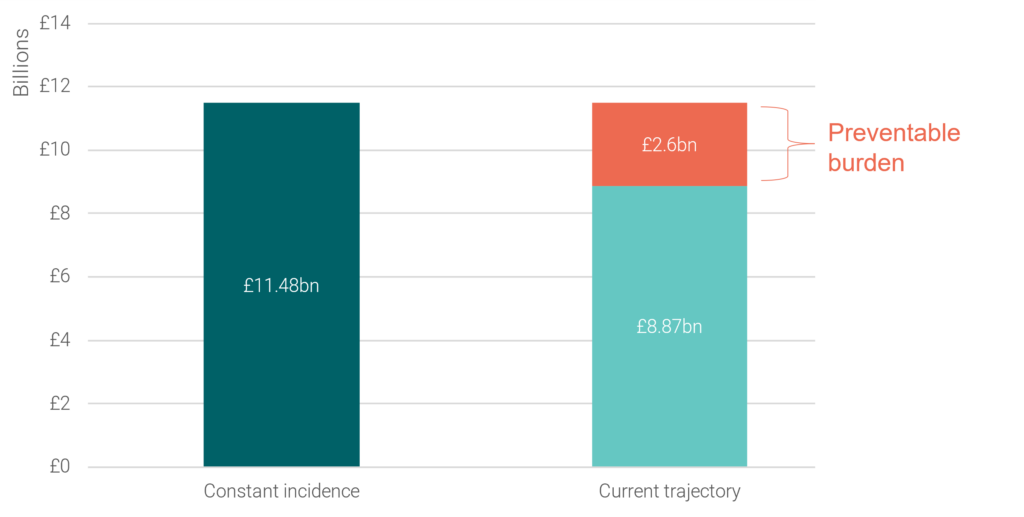Cervical cancer imposes a substantial burden on patients, their support networks, the NHS, and society at large. This report underscores the significant socioeconomic savings that can be achieved by reaching the WHO’s elimination goal of 4 cases per 100,000 women, providing further impetus to take action to reach the ambitious 2040 elimination target set by NHS England.
Key takeaways
- Cervical cancer places a significant preventable burden on patients and their support systems, the NHS, and wider society. The lifetime cost of cervical cancer is approximately £210,000 per case.
- The total preventable burden of cervical cancer in the UK is £406 million – based on the difference between socioeconomic costs at the current UK incidence rate and the WHO elimination target of 4 cases per 100,00 women.
- The preventable burden of cervical cancer is equivalent to 40% of the UK combined spending on immunisation and early detection programmes pre-COVID-19, and approximately 8% of the total UK pre-COVID-19 spending on preventative care.
- The UK could save approximately £2.6 billion by achieving the WHO elimination threshold, and this is likely an underestimation of the full socioeconomic savings.
- Implementing a plan with measurable actions and milestones across all UK nations is crucial for achieving the aspirational 2040 target of elimination by NHS England and the full extent of the socioeconomic savings we have presented.
The Burden
Our comprehensive analysis reveals that cervical cancer’s lifetime cost per case in the UK is a staggering £210,000. This encompasses healthcare system expenses, individual patient costs, and wider societal impacts from morbidity and mortality, as Figure 1 shows. Workplace productivity losses (63% of the total burden), and informal care losses (22% of the total burden) constitute the major components, highlighting the multifaceted nature of the challenge.
Figure 1 Framework of cervical cancer socioeconomic burden

* Productivity loss quantifications already include tax returns due to workplace absenteeism. From a societal perspective, tax returns and costs to the social security system (e.g., welfare payments, sickness benefits) are considered a transfer and therefore should not be included in the full cost of disease.
As of 2023, the preventable socioeconomic burden of cervical cancer in the UK amounts to £406 million, equivalent to 40% of the nation’s combined spending on immunisation and early detection programs pre-COVID-19. This also represents approximately 8% of the total pre-COVID-19 spending on preventative care. The preventable burden represents 59% of the total burden, meaning if cervical cancer had already been eliminated, significant resources would have been freed up for other healthcare measures.
Looking into the Future
Our projections suggest that achieving the WHO elimination threshold by 2046 could save the UK a remarkable £2.6 billion over the period from 2023 to 2046 as Figure 2 show. While NHS England’s commitment to elimination by 2040 is commendable, a measurable plan is imperative to maintain momentum and bring the socioeconomic benefits closer to reality.
Figure 2 Achieving the WHO elimination target in the UK by 2046 could save £2.6 billion

Constant incidence = current incidence of 9.7 per 100,000 maintained until 2046 Current trajectory = elimination target of 4 per 100,000 achieved in 2046, as per published epidemiological estimate for UK
The report underscores the need for a nationwide strategy, extending beyond NHS England, to propel the UK towards cervical cancer elimination. A specific, measurable plan with defined actions and milestones is necessary to actualise the 2040 target. Adopting similar strategies across all UK nations — Northern Ireland, Scotland, and Wales — will not only fortify the commitment to elimination but also expedite the journey toward a cervical cancer-free future.
Unveiling Potential Savings
Beyond the quantifiable financial gains, the report may underestimate the true extent of the socioeconomic burden associated with cervical cancer. Unaccounted impacts such as the loss of a parent on a child’s educational attainment are an example of wider set of hidden costs. NHS England’s commitment, if reinforced by a tangible plan of action, has the potential to surpass predicted savings, bringing us closer to a future where cervical cancer is not just treatable but entirely preventable.
This report, ‘The Socioeconomic Burden of Cervical Cancer in the UK: What are the Benefits of Achieving the WHO Elimination Target?’ was commissioned and funded by MSD.




